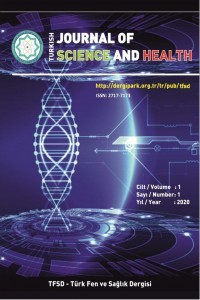Medial ve Lateral Ark Açıları ile Ayak Uzunluğunun Yaş, Cinsiyet ve Taraf Farklılığı Açısından Radyolojik Olarak İncelenmesi
Ayak morfometrisi, Radyografi, Medial ark açısı, Lateral ark açısı, Ayak uzunluğu
Radiological Research of Medial and Lateral Arch Angles and Foot Length In Terms of Age, Gender and Side Differences
foot morphometry, Radiography, Medial arch angle, Lateral arch angle, Foot length,
___
- Alkenani, N., Alaqil, M., Murshid, A. et al. (2017). Standardized radiological values of foot among Saudi population. Saudi Journal of Sports Medicine, 17.3 (2017): 144. https://dx.doi.org/ 10.4103/sjsm.sjsm_20_17
- Benirschke, S. K., Kramer, P. A. (2011). Variability in Foot Morphology. Orthopaedic Discoveries, University of Washington Orthopaedics & Sports Medicine, 2011, 26.
- Bourdet, C., Seringe, R., Adamsbaum, C., et al. (2013). Flatfoot in children and adolescents. Analysis of imaging findings and therapeutic implications. Orthopaedics & Traumatology: Surgery & Research 99.1 (2013): 80-87. https://dx.doi.org/10.1016/j.otsr.2012.10.008
- Cebulski-Delebarre, A., Boutry, N., Szymanski, et al. (2016). Correlation between primary flat foot and lower extremity rotational misalignment in adults. Diagnostic and interventional imaging, 97(11), 1151-1157. https://dx.doi.org/10.1016/j.diii.2016.01.011
- Ceccarini, P., Rinonapoli, G., Gambaracci, G., et al. (2018). The arthroereisis procedure in adult flexible flatfoot grade IIA due to insufficiency of posterior tibial tendon. Foot and Ankle Surgery, 24(4), 359-364. https://dx.doi.org/10.1016/j.fas.2017.04.003
- Chiroma, S. M., Philip, J., Attah, O., et al. (2015). Comparison of the foot height, length, breadth and foot types between males and females Ga’anda people, Adamawa, Nigeria. IOSR Journal of Dental and Medical Sciences, 14(8), 89-93. https://dx.doi.org/10.9790/0853-14818993
- Danborno, B., Elukpo, A. (2008). Sexual dimorphism in hand and foot length, indices, stature-ratio and relationship to height in Nigerians. The Internet Journal of Forensic Science, 3(1), 379-383. https://dx.doi.org/10.5580/379
- Eslami, M., Tanaka, C., Hinse, S., et al. (2009). Acute effect of orthoses on foot orientation and perceived comfort in individuals with pes cavus during standing. The Foot, 19(1), 1-6. https://dx.doi.org/10.1016/j.foot.2008.06.004
- Gülçimen, B., Ülkü, S. (2008). İnsan Ayağı Biyomekaniğinin İncelenmesi. Uludağ University Journal of The Faculty of Engineering, 13(2).
- Hill, M., Naemi, R., Branthwaite, H., et al. (2017). The relationship between arch height and foot length: Implications for size grading. Applied ergonomics, 59, 243-250. https://dx.doi.org/10.1016/j.apergo.2016.08.012
- Igbigbi, P. S., Mutesasira, A. N. (2003). Calcaneal angle in Ugandans. Clinical Anatomy: The Official Journal of the American Association of Clinical Anatomists and the British Association of Clinical Anatomists 16.4 (2003): 328-330. https://dx.doi.org/10.1002/ca.10104
- Lautzenheiser, S. G., Kramer, P. A. (2013). Linear and angular measurements of the foot of modern humans: A test of Morton's foot types. The Anatomical Record, 296.10 (2013): 1526-1533. https://dx.doi.org/10.1002/ar.22764
- McPoil, T. G., Cornwall, M. W., Vicenzino, B., et al. (2008). Effect of using truncated versus total foot length to calculate the arch height ratio. The Foot, 18(4), 220-227. https://dx.doi.org/10.1006/j.foot.2008.06.002
- Moore, K. L., Dalley, A. F. (2013) Clinically oriented anatomy. Lippincott Williams & Wilkins.
- Mootanah, R., Song, J., Lenhoff, M. W., et al. (2013). Foot type biomechanics part 2: are structure and anthropometrics related to function? Gait Posture, 2013;37(3):452–6. https://dx.doi.org/10.1006/j.gaitpost.2012.09.008
- Ozden, H., Balci, Y., Demirüstü, C., et al. (2005). Stature and sex estimate using foot and shoe dimensions. Forensic Science International, 147(2-3), 181-184. https://dx.doi.org/10.1006/j.forsciint.2004.09.072
- Sanli, S. G., Kizilkanat, E. D., Boyan, N., et al. (2005). Stature estimation based on hand length and foot length. Clinical Anatomy: The Official Journal of the American Association of Clinical Anatomists and the British Association of Clinical Anatomists, 18(8), 589-596. https://dx.doi.org/10.1002/ca.20146
- Sen, J., Ghosh, S. (2008). Estimation of stature from foot length and foot breadth among the Rajbanshi: an indigenous population of North Bengal. Forensic Science International, 181(1-3), 55-e1. https://dx.doi.org/10.1016/j.forsciint.2008.08.009
- Shoukry, F. A., Aref Y. K., Sabry, A. A. E. (2012). Evaluation of the normal calcaneal angles in Egyptian population. Alexandria Journal of Medicine 48.2 (2012): 91-97. https://dx.doi.org/10.1016/j.ajme.2011.07.001
- Sturbois-Nachef, N., Allart, E., Grauwin, M. Y., et al. (2019). Tibialis posterior transfer for foot drop due to central causes: Long-term hindfoot alignment. Orthopaedics & Traumatology: Surgery & Research, 105(1), 153-158. https://dx.doi.org/10.1016/j.otsr.2018.11.013
- Torun, B. İ., Çay, N. (2017). Ayak Arkus Açısı ve Ayak Uzunluğu Arasındaki İlişki. KAFKAS: 172. (2018). https://dx.doi.org/10.5505/kjims.2018.81557
- Yücel, A. H., Özandaç, S., Kabakcı, A. G. Et al. (2017). Sağlıklı Bireylerde Ayak Antropometrik İndeks Değerlerinin Belirlenmesi. Harran Üniversitesi Tıp Fakültesi Dergisi, 14(2), 95-103.
- Başlangıç: 2020
- Yayıncı: Ümit Muhammet KOÇYİĞİT
COVID -19 Tanılı Hastaların Cerrahisi: Perioperatif Savunma
Gökçen AYDIN AKBUGA, Yeliz SÜRME
Production Cross-Section of 51Cr Radioisotope Using Artificial Neural Networks
Bazı aktif maddelerin Kovid-19 için inhibisyon etkileri
Hemşirelerin Ekip Çalışması ve İş Doyumlarının Belirlenmesi
Esin KAVURAN, Eda AY, Emrah AY, Meyreme AKSOY
HEMŞİRELİK FAKÜLTESİ İNTÖRN ÖĞRENCİLERİNİN BİREYSELLEŞTİRİLMİŞ BAKIMI DEĞERLENDİRMELERİ
Hazel BAĞCI, Şebnem ÇINAR YÜCEL, Sinem ÖZER, Hilal ÇETİNKAYA
The Effect of Social Media on Nursing Students’ Ethical Sensitivity and Professional Development
Şahizer ERAYDIN, Arzu ERKOÇ HUT
Complementary Therapy Use in with Diabetes Individuals and Information Source
Saadet CAN ÇİÇEK, Fatma ARIKAN, Satı CAN, Şefika DALKIRAN, Handan ANKARALI
